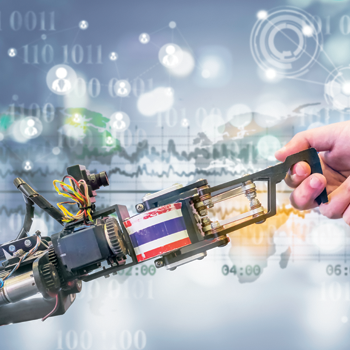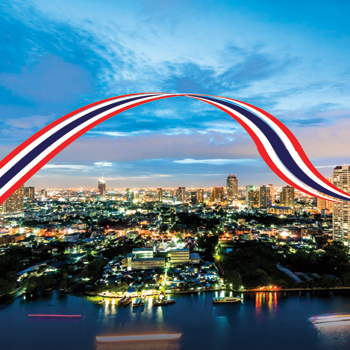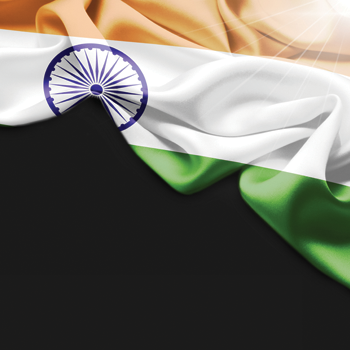จากอุตสาหกรรมอาหารปลายน้ำ…สู่ปลายทาง 4.0
โดย: นริศร์ธร ตุลาผล
Narithtorn Tulaphol
Economic Intelligence Center (EIC)
Siam Commercial Bank Public Company Limited
narithtorn.tulaphol@scb.co.th
ปัจจุบันการปฏิวัติอุตสาหกรรม 4.0 เป็นเรื่องที่ภาคธุรกิจทั้งในไทยและต่างประเทศให้ความสนใจอย่างมาก โดยอาศัยการใช้ประโยชน์จาก Big Data เป็นเครื่องมือหลักในการพัฒนาธุรกิจ
ธุรกิจอาหารในอุตสาหกรรมปลายน้ำมีศักยภาพในการปรับตัวเพื่อรองรับกับการก้าวไปสู่อุตสาหกรรม 4.0 มากกว่าผู้เล่นในระดับต้นน้ำและกลางน้ำ เนื่องจากมีความใกล้ชิดกับผู้บริโภคมากกว่า ทำให้เข้าใจความต้องการและสามารถนำเสนอสินค้าและบริการในรูปแบบที่แตกต่างและตอบโจทย์ได้มากขึ้น ซึ่งในอนาคตโมเดลธุรกิจแบบนี้มีแนวโน้มที่จะสร้างพฤติกรรมการบริโภคอาหารที่มีความเฉพาะเจาะจงและหลากหลายมากขึ้น ทั้งนี้ การเปลี่ยนแปลงดังกล่าวส่งผลให้ผู้เล่นอื่นๆ ในอุตสาหกรรมอาหารทั้งห่วงโซ่อุปทานจำเป็นต้องปรับตัว เพื่อให้สามารถพัฒนาศักยภาพและก้าวข้ามขีดจำกัดของธุรกิจสู่การเติบโตได้อย่างยั่งยืนในระยะยาว
อุตสาหกรรม 4.0 เป็นหนึ่งในการเปลี่ยนแปลงที่ผู้เล่นในอุตสาหกรรมอาหารไม่ควรมองข้าม ถึงแม้ว่าปัจจุบันอุตสาหกรรมการผลิตส่วนใหญ่จะสามารถผลิตสินค้าจำนวนมากได้อย่างมีประสิทธิภาพก็ตาม แต่เทคโนโลยีการผลิตที่เป็นอยู่ก็ยังมีข้อจำกัดหลายประการที่ยังไม่สามารถก้าวข้ามได้ เช่น ปัญหาความผิดพลาดจากกระบวนการผลิต หรือการป้อนข้อมูลความต้องการจากปลายทางที่ไม่ Real-time ทำให้ไม่สามารถปรับเปลี่ยนกระบวนการผลิตได้ทัน เป็นต้น ส่งผลให้ภาคธุรกิจทั่วโลกต่างหันมาให้ความสนใจกับการปฏิวัติอุตสาหกรรมครั้งที่ 4 ที่กำลังจะเกิดขึ้นอย่างมาก เนื่องจากจุดเปลี่ยนสำคัญของการปฏิวัติอุตสาหกรรมครั้งนี้ คือ การนำเอาเทคโนโลยีในยุคดิจิทัลมาปรับใช้ เพื่อช่วยให้การส่งผ่านข้อมูลระหว่างผู้เล่นในห่วงโซ่อุปทานทำได้รวดเร็วและสะดวกมากขึ้น อย่างไรก็ดี การปรับใช้ไม่ได้หยุดอยู่เฉพาะในอุตสาหกรรมการผลิตเท่านั้น แต่ยังครอบคลุมถึงขั้นตอนการจัดหาวัตถุดิบ ไปจนถึงการส่งสินค้าให้ถึงมือผู้บริโภคขั้นสุดท้าย ซึ่งข้อมูลดังกล่าวส่งผลให้เกิดประโยชน์อย่างมากมาย ยกตัวอย่างเช่น อุปกรณ์การผลิตที่สามารถสื่อสารและแยกแยะบรรจุภัณฑ์อาหารที่แตกต่างกันได้ ซึ่งจะช่วยให้การผลิตอาหารมีความผิดพลาดน้อยลงอย่างมาก หรือการเชื่อมต่อความต้องการบริโภคอาหารที่หลากหลายสู่กระบวนการผลิตอาหารที่จำเพาะเจาะจง (Mass customization) เพื่อตอบสนองความต้องการของผู้บริโภคได้อย่างมีประสิทธิภาพมากขึ้น
Industrial revolution 4.0—using Big Data as a tool for developing business—has generated much interest in Thailand and abroad.
The downstream food industry as an especially promising candidate for a 4.0 upgrade, more so than their upstream or midstream counterparts. This is due to the fact that downstream businesses have better access to consumer data, enabling them to present products and services in myriad ways and respond efficiently to consumer preferences. This business model is likely to lead to ever more specific yet diverse food consumption behaviors. As such, other players in the food industry supply chain will have to adjust accordingly in order to enhance their capacity and expand beyond their current limits towards sustainable long term growth.
The food industry cannot afford to overlook the coming of Industry 4.0. Although food manufacturers today are able to produce large quantities of products efficiently, technology is still limited, as seen in defects due to production processes or time-lagged downstream data input resulting in the failure to implement timely production process adjustments. All over the world, the business sector is paying close attention to the next industrial revolution led by what has been termed Industry 4.0: The use of digital technology to enhance communications between all players in the supply chain. This new technology is not only limited to production processes, but also covers everything from raw material sourcing to final delivery. Digital technology can vastly enhance all of these processes. For example, manufacturing equipment will be able to communicate with objects and sort different types of food packaging, which will greatly reduce errors. Consumer preferences for different types of foods can also be incorporated into mass customization processes with speed and efficiency.





